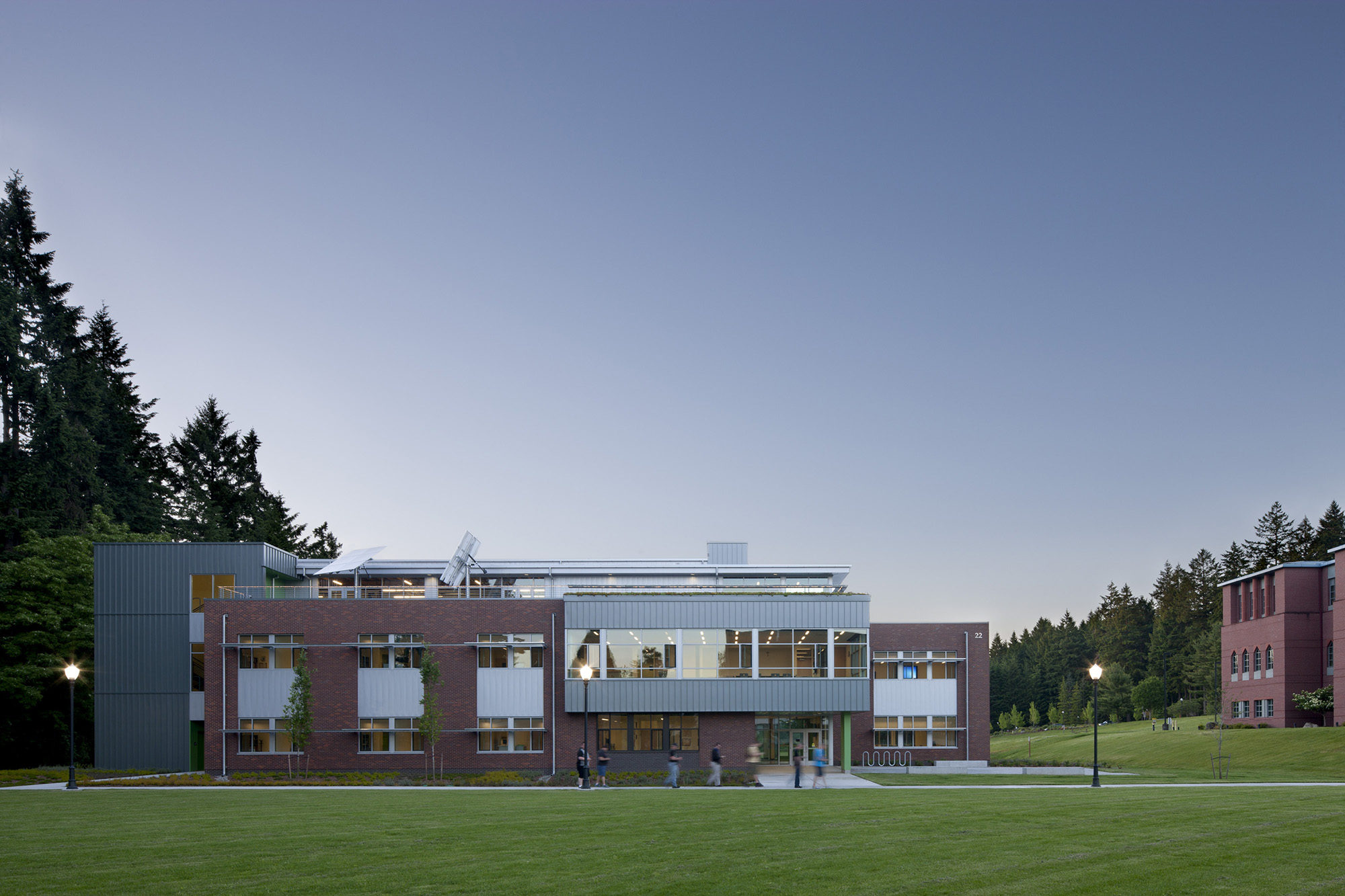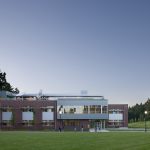At Cebula Hall, engineering students only have to look as far as the structure that surrounds them to find an example of technical innovation that achieves sustainable design goals at a conventional cost. Saint Martin’s University students can analyze and program photovoltaic panels and perform experiments on the building’s exposed structural elements. Administrators hope this hands-on experience will inspire students to pursue careers that tackle 21st century challenges such as finding new ways to harvest renewable energy and managing limited water resources, carrying out one of the Benedictine college’s core values: service to the community.
For decades the Hal and Inge Marcus School of Engineering operated within a building that was originally used as a saw mill. Faculty, staff and students persevered and developed a strong program despite the facility’s limitations. In addition to the building’s physical challenges, it didn’t support the program’s desire for rigor and collaboration.
The design and construction of a new engineering facility was inspired by a 2006 conference by the National Science Foundation, which brought together an international group of prominent engineers and scientists to identify global challenges for the 21st century, including sustainability, health, reducing vulnerability and joy of living. Much of their list of challenges incorporated some element of engineering to address energy and water challenges and improve community infrastructure.
Saint Martin’s University desired a new engineering building that reflected the importance of these issues and prepared students to tackle these types of challenges. The university sought to create a new engineering building that was noteworthy for its sustainable achievements, while creating a teaching/learning environment that was effective and inspirational for students and faculty.
Cebula Hall is a 26,900 ft2 three-story facility that contains an environmental lab, structures lab, thermal engineering lab, materials lab, CAD modeling lab, classrooms, seminar spaces, conference rooms, an engineering library, collaborative learning settings, and administrative space for faculty and the dean of the Hal and Inge Marcus School of Engineering. The LEED Platinum building, which opened in 2012, was completed for a modest $225/ft2 and boasts an energy use intensity (EUI) of 18.25 kBtu/ft2.
A Collaborative Process
This project used a “team build” process, which brought the general contractor and consultants on board early in the design process. The owner established collaboration guidelines early in the process, including student and stakeholder engagement.
Identification of key design/build subcontractor partners early was an important step in achieving the lofty sustainable goals. These subcontractors provided valuable insights to effectively accommodate the various systems and supported the project program and mission. These partners engaged in the process through extensive use of Building Information Modeling (BIM) to coordinate ideas and building systems in real time and facilitate communication.
Passive Energy Reduction
Design features and construction systems were chosen strategically for durability, to maintain the budget and provide the appropriate balance between cost and performance. A reduction in window area allowed for higher efficiency while providing sufficient views and daylight. All south-facing windows are outfitted with external shading to reduce cooling requirements.
A facility this height and size would typically be a steel structure. However, the design and construction team used a panelized wood-framed system to provide economy and improved thermal efficiency over steel. A wall assembly that includes batt insulation in the wall cavity and exterior rigid insulation provides a U-value of 0.044. Upgraded continuous insulation in the roof provides an R-value of R-35.
One of the biggest contributors to the performance of the thermal envelope is the continuous air and vapor barrier that encapsulates the structure. Carefully detailing and installing a continuous air barrier around opening and penetrations is critical to reducing energy loss within a building’s envelope.
Continuous air and vapor barriers are now a requirement for the Washington state energy code. Reducing the building’s infiltration loads helped to downsize the mechanical system.
Active Energy Reduction
Ventilation. Occupant density is high for most university buildings, so ventilation was a key factor. Early energy modeling proved that 70% of the design heating load was from ventilation alone.
The design team decided to use the most energy-efficient ventilation system available, a 90% efficient heat recovery unit. The system reverses flow approximately every 15 seconds and uses the thermal mass of the heat exchanger plates to boost the system’s efficiency.
Geothermal System. The backbone of the mechanical system is the geothermal system. The new engineering building is located to create a new campus quadrangle. This positions the building adjacent to an expansive open space with enough room to install a horizontal “slinky” system, which is more cost-effective than a vertically oriented well system. The loop field for this project uses approximately 31,750 ft2 of ground surface area.
Given that the gross building area is 26,900 ft2, this layout is a more efficient loop field area to gross building area ratio than the standard 3:1. Good soil conductivity, an efficient building envelope and choice of systems allowed for a smaller ground area.
The geothermal loop field is oversized to provide a more favorable entering water temperature (a low of 38°F in the winter and a high of 65°F in the summer) instead of a standard temperature range (a low of 30°F in the winter and a high of 95°F in the summer). High efficiency, dual-stage geothermal mechanical units were chosen to work with pumps, which vary speed and reduce power use internally as the geothermal units turn on and off.
Economizers. One of the key outcomes of analyzing the energy model early in design was the determination that not using economizers was more energy effective than using them. Economizers are typically a code requirement in the state of Washington, but the code includes an exception to eliminate economizers when a lack of energy savings can be shown.
In a mild climate like the Pacific Northwest, an economizer usually has a quick payback; however, the model showed that the total mechanical cooling use would only be 6,300 kWh. With electric energy costs at around $0.08/kWh, this equates to an average of $504 per year. The estimated costs of an economizer system to every geothermal heat pump was more than $40,000, representing a payback of almost 80 years.
Lighting and Controls. Artificial lighting is primarily efficient electronic ballast and T5 fluorescent lamps. LEDs were considered, but they did not fit within the budget for all the lighting needs.
This building is also outfitted with a state of the art controls system. It provides the ability to use energy saving strategies such as optimum start, extensive scheduling, and lighting control. Each classroom includes CO2 controls, which help further reduce ventilation energy use.
Solar Photovoltaics. The university also expressed a desire to include solar photovoltaics. The design team looked at a number of systems and elected to use a thin-film technology that was integrated directly onto the roofing material.
Not requiring an upgraded structural system or solar racking system helped keep the costs in line and also allowed for two dual-axis solar tracking arrays. The tracking arrays are located on the third-floor rooftop lab, which provides teaching and learning space that includes the operable solar array and room for additional experimental features.
Commissioning. The early involvement of the commissioning agent in the project provided helpful insight throughout construction and helped the team avoid some of the more common and challenging adjustments. Ultimately, the commissioning agent commented that “this is the most energy-efficient, simple system, we’ve ever dealt with.”
Simple Controls. Usually energy efficiency brings about complicated controls strategies and untested approaches. This building was designed from the beginning to be simple enough that maintenance staff could handle changes without the concern of eroding energy savings.
Energy use in 2013 proved the simplicity of this system. The building’s energy use was within 10% of the energy model. Measurement and verification identified where the differences exist.
Interestingly, the increase in plug load energy use from the energy model helped heat the facility and decreased the overall HVAC energy use. The higher plug loads were primarily from the computer labs, and they affected the cooling system somewhat.
Building as an Educational Tool
The arrangement of spaces in the engineering building focuses on beneficial relationships that encourage collaboration and educational cross-pollination as well as functionality within the individual spaces. Transparency, proximity and access to shared spaces are also key to the success.
Labs and classrooms are positioned directly across from a transparent faculty office suite that is outfitted with a glass writing surface for walls. This design supports planned and impromptu study and research opportunities as well as visibility between spaces.
This building exposes, expresses and displays many engineered systems as a way of surrounding faculty and students with real-world examples of their studies. Many of the building’s structural, civil and mechanical systems are displayed or “peeled back” to facilitate dialogue and support the school’s curriculum.
The two dual-axis solar panels located on the rooftop lab allow students to study the benefits of tracking devices, solar orientation and the production of solar energy. The freestanding devices allow for easy retrofitting of future solar panel technologies. The challenges of developing affordable renewable energy sources are expected to be a research focus for the school.
One of the labs in the building is designed for education as well as supporting research. The thermal engineering program has previously garnered testing and technical support from NASA to build a heat flux simulator.
In anticipation of future research grant-funded projects, the thermal engineering lab space is designed to precisely control the interior environment. It also provides a flexible layout and access to utilities that support the innovative constructs created for research and learning in thermal dynamics and mechanical systems.
The mechanical system in this space was required to provide absolutely no air movement and little to no temperature fluctuation over the course of several hours. A geothermal radiant heating and cooling system with direct controls to the ventilation system was the key to providing everything the thermal lab required.
Sustainable Water Strategies
Inside, low-flow fixtures help reduce water use. Outside, water needs were minimized by selecting native plants that would not require irrigation after initial establishment. Sedums are used for the green roof applications and perform well given the Northwest climate.
Storm water is treated in two ways. Water quality is addressed through the use of rain gardens and surrounding pervious soil conditions. Water quantity needs are met with a shared storm water facility that was previously built and shared with the neighboring municipal building complex.
LEED Platinum on a Budget
The construction cost of Cebula Hall was $225/ft2, proving that highly sustainable buildings can be built affordably relative to their conventional counterparts. On college campuses, construction costs for non-LEED certified laboratory buildings typically start around $275/ft2 to $400/ft2, and go up from there — sometimes significantly.
At 26,900/ft2, the compact three-story building absorbed the cost burden of laboratories, vertical circulation and a rooftop lab. Achieving high performance at such a modest cost is significant given the lack of economy of scale.
Life-cycle costs were considered for most elements and systems. The ground source HVAC system has been calculated at a five-year payback and made sense from a first-cost and life-cycle cost perspective. The only long-term return on investment was the solar panel installation, which has an approximate 25-year payback.
Conclusion
Cebula Hall is living proof that sustainable, high performing buildings can be achieved with cost-effective measures. The facility provides a healthy, high performing and attractive environment while supporting a growing engineering program that hopes to contribute to the advancement of sustainability.
This post was originally published in the Spring 2014 edition of High Performing Buildings. Copyright 2014 ASHRAE.




